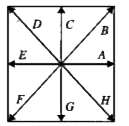ABCDEF is a regular hexagon. Find the vector →AB+→AC+→AD+→AE+→AF in terms of the vector →AD
1
2
3
none of these
The correct Answer is:C

−−→AB+−−→AC+−−→AD+−−→AE+−−→AF
=−−→ED+−−→AC+−−→AD+−−→AE+−−→CD[∴−−→AB=→ED,→AF=→CD]
−−→AC+−−→CD+(−−→AE+−−→ED)+−−→AD
=−−→AD+−−→AD+−−→AD=3−−→AD
Topper's Solved these Questions
Similar Questions
Consider the regular hexagon ABCDEF with centre at O (origin).
Q. AD+EB+FC is equal to
View SolutionIf ABCDEF is a regular hexagon then −−→AD+−−→EB+−−→FC equals :
View SolutionIf ABCDEF is a regualr hexagon, then −−→AC+−−→AD+−−→EA+−−→FA=
View SolutionIn a regular hexagon ABCDEF, −−→AE
View SolutionA number of vectors are as shown in .They can be combined in various ways , like →A+→C=→B . What is the value of (a) →E+→C (b) →A+→F (c ) →A+→D (d) →E+→A (e ) →A−→B .

View SolutionIf ABCDEF is a regular hexagon with −−→AB=→a and −−→BC=→b, then −−→CE equals
View SolutionIf ABCDEF is a regular hexagon, prove that −−→AC+−−→AD+−−→EA+−−→FA=3−−→AB
View SolutionABCDEF si a regular hexagon with centre at the origin such that A→D+E→B+F→C=λE→D. Then, λ equals
View SolutionIn a regular hexagon ABCDEF, prove that −−→AB+−−→AC+−−→AD+−−→AE+−−→AF=3−−→AD
View SolutionIf ABCDE is a pentagon, then
−−→AB+−−→AE+−−→BC+−−→DC+−−→ED+−−→AC is equal to
View Solution
